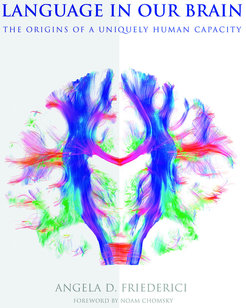Language makes us human
Angela D. Friederici explains in her new book why our language capacity must be innate and what happens when we generate and comprehend sentences.

“Humans are born to learn language”, Angela D. Friederici begins her new book “Language in Our Brain” by discussing the structures in our brains which enable us to develop this fascinating medium which we use to speak and write, think and poetise, email and tweet. “We learn our mother tongue without any formal lessons and are nevertheless able to handle it in every situation without even thinking about it.” A capacity which remains reserved for us humans. Indeed, apes, dogs, and parrots are able to learn words by associating an abstract symbol or a sound with an object. But they are not able to combine them according to grammatical rules to make them into meaningful sentences.
But what is it that enables us to master this skill? What is the basis of this purely human achievement? These questions were at the starting point of linguist, psychologist and neuroscientist Angela D. Friederici’s research career about 40 years ago. Now she gives us the answers. In her profound work, just released by the renowned publishing house MIT Press of Massachusetts Institute of Technology (MIT) in Cambridge, she explains how the biological structures in the brain interact—and thereby sounds become words, word groups, sentences and finally content within milliseconds.
And Professor Friederici would know. Thanks to her research results over the last four decades we have a rough picture of how the brain and mind work together when we process language. One of her crucial findings is that we usually understand language within three steps: First, neurons check if a sentence’s form is correct, its grammar. This happens automatically within about 200 milliseconds. After that, in the following 200 to 400 milliseconds the brain tries to encode the meaning of the words. If the structure of the sentence and the words do not fit, a new analysis cycle follows.
In the spotlight of her research and her book is one fibre tract in the brain, explored by Friederici and her team, that has made massive waves in the world of language research: the so-called fasciculus arcuatus. This connection works similar to a data highway on which language relevant information is transported and it is therefore the crucial structure for processing grammar—the actual basis of language. It is highly developed in the brain of every adult on earth und varies marginally depending on a person’s native language. Therefore, its the neuroscientific evidence for linguist Noam Chomsky’s theory, wherby all languages are based on common grammar rules and the ability to recognise them are innate in humans.
“Humans possess this ability from birth. However, certain rules of every language have be to learned”, states Friederici. “Therefore, in the sensitive phase of development linguistic communication has to be encouraged to fully develop the fasciculus arcuatus and thereby the full language capacity.” So-called banned kids such as Kasper Hauser or “Genie” in the 1970s thus never managed to communicate in a proper language.
The long searched for the “missing link” could lay in this fibre tract, which explains the leap forward of the simple sound association of animals to the matured language of humans. This could be because this fibre tract only exists in adult humans but not in other primates and infants, and consequentially language capabilities are more advanced. Even linguist Chomsky is convinced by this idea. In the prologue to “Language in Our Brain” he also supposes that this brain structure “appears to have evolved to subserve the human capacity to process syntax, which is at the core of the human language faculty.”
About the author:
For almost forty years Angela D. Friederici has been investigating how humans learn language and what happens jn our heads during the speaking and understanding process. Through her interdisciplinary approach as a linguist, psychologist and neuroscientist, she has succeeded in building a bridge between the humanities and natural sciences and in grasping language as a whole. Angela Friederici’s findings have earned her a reputation as one of the most renowned researchers worldwide in the field of the neurobiology of language.
Angela D. Friederici is Director of the Max Planck Institute for Human Cognitive and Brain Sciences in Leipzig, Germany, and Vice President of the Max Planck Society.
